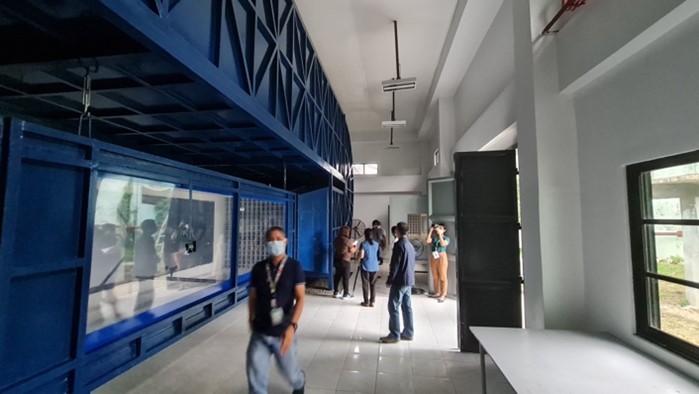

The wind tunnel in the laboratory that simulates wind speeds to test and calibrate small-scale wind turbines.
To advance the Philippines’ capability in harnessing energy from the wind, the Department of Science and Technology – Philippine Council for Industry, Energy and Emerging Technology Research and Development (DOST-PCIEERD) funded the establishment of the country’s first wind turbine research, development and testing laboratory in Iloilo City that was launched on Tuesday.
Developed and housed by the Central Philippine University (CPU), the laboratory will spearhead R&D initiatives that will serve as basis to help policymakers upgrade and formulate renewable energy (RE) policies, assess island communities’ potential in harnessing wind power and aid local government units (LGUs) in doing so, and provide various testing services to evaluate the performance of wind turbines to ensure that the country’s growing wind farms can maximize RE production.
“As CPU, through its Affiliated Renewable Energy Center (AREC), had been involved in wind energy systems development and installation as early as the 90s, it is high time that we build an R&D and testing lab to analyze the long-term performance of existing wind farms and help the sector take off,” said Project Leader and CPU Mechanical Engineering Department Chairperson Engr. Jeriel G. Militar.
Moreover, the facility will be the venue for training programs on the use of wind tunnels, wind monitoring systems, and prototyping software and hardware. It will also lead to the design of wind turbine prototypes, guides for the conduct of wind resource assessment, and protocols or standard procedures in testing.

From left: DOST-PCIEERD Deputy Executive Director Engr. Niñaliza Escorial, DOST Secretary Fortunato T. de la Peña, Central Philippine University President Dr. Teodoro C. Robles, and DOST VI Regional Director Rowen Gelonga led the launching and inauguration of the Wind Turbine Development and Testing Laboratory on 25 May 2022.
“We envision that our initiatives through this lab, coupled with the availability of local support for training, repair, and maintenance, will encourage the adoption of local technologies by the local communities and contribute to the increase in the utilization of wind energy, a clean and renewable energy, in the region,” added Militar.
The lab is strategically established in Panay Island as it is one of the identified suitable places to generate wind power in the Philippines, especially for small-scale wind energy power applications.
DOST-PCIEERD, as the funding and monitoring agency of the project through its Institution Development Program (IDP), is optimistic that CPU’s wind turbine development and testing laboratory will unlock the country’s capability in generating wind energy.
“We are confident that the facility will further showcase the Philippines’ extensive wind potential among Southeast Asian countries, leading the accelerated growth of the wind energy market. This inspires us at DOST-PCIEERD to assist more institutions establish and upgrade their own facilities to enrich their regions with R&D initiatives that uplift the whole nation,” said DOST-PCIEERD Executive Director Dr. Enrico C. Paringit.
To date, the IDP has helped set up and upgrade 37 labs all over the country, amounting to a total investment of P194.42 million. The grant covers the purchase of laboratory equipment and facilities, including highly specialized software and other relevant operational expenses.
DOST-PCIEERD will accept proposals under the IDP this year, so interested institutions are recommended to stay updated through the Council’s social media accounts (@dostpcieerd) and/or website at https://www.pcieerd.dost.gov.ph.
To get more details on how to apply, please see https://pcieerd.dost.gov.ph/supported-programs-projects/strategic-thrusts-and-programs/240-institution-development.




